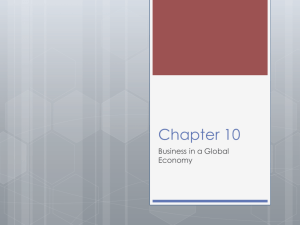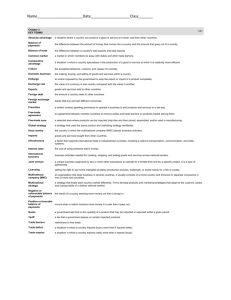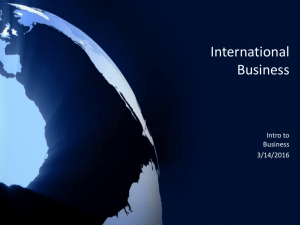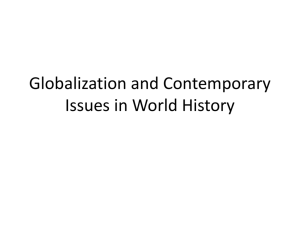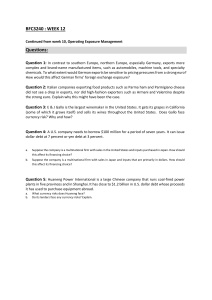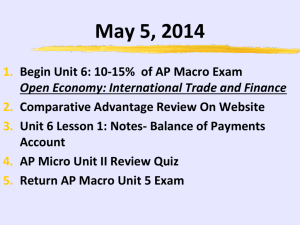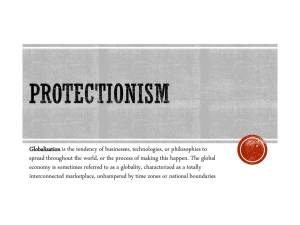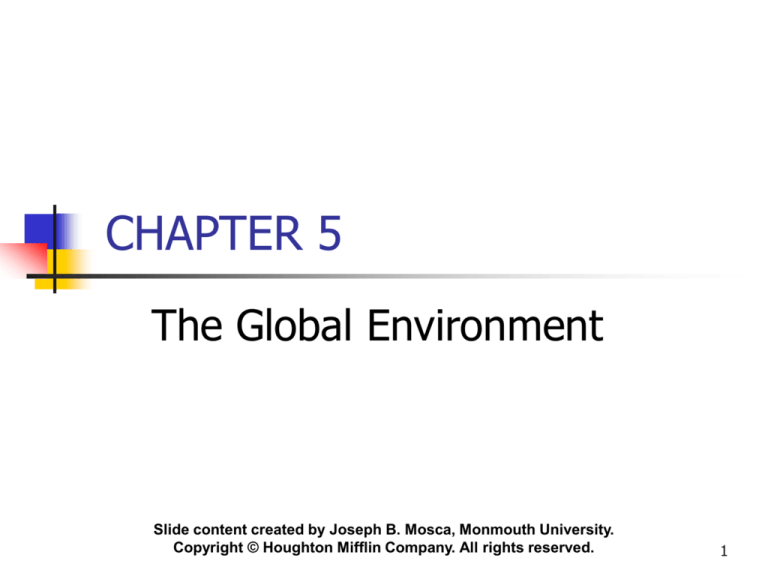
CHAPTER 5
The Global Environment
Slide content created by Joseph B. Mosca, Monmouth University.
Copyright © Houghton Mifflin Company. All rights reserved.
1
The Meaning of International
Business
Domestic business: a business
that acquires all its resources and
sells its products or services
within a single country.
International business: a business
that is primarily based in a single
country but acquires some
meaningful share of its resources
or revenues (or both) from other
countries.
2
Meaning of International
Business (cont’d)
Multinational business: one
that has a worldwide
marketplace from which it
buys raw materials, borrows
money, and manufactures its
products and to which it
subsequently sells its products.
Global business: a business
that transcends national
boundaries and is not
committed to a single home
country.
3
Levels of International
Business Activity
Lowest
DOMESTIC
BUSINESS
Level of International Activity
INTERNATIONAL
BUSINESS
MULTINATIONAL
BUSINESS
Highest
GLOBAL
BUSINESS
4
Terms to Remember:
Market economy:
Economy based on the
private ownership of
business and allows
market factors such as
supply and demand to
determine business
strategy.
Market system:
Clusters of countries
that engage in high
levels of trade with
each other.
5
Managing the Process of
Globalization
Exporting: making a product in the firm’s
domestic marketplace and selling it in another
country.
Importing: bringing a good, service, or capital
into the home country from abroad.
Licensing: an arrangement whereby a firm
allows another company to use its brand
name, trademark, technology, patent,
copyright, or other assets in exchange for a
royalty based on sales.
6
Processes of Globalization
(cont’d)
Strategic alliance: a
cooperative arrangement
between two or more firms
for mutual gain.
Joint venture: a special type
of strategic alliance in which
the partners share ownership
of a new enterprise.
7
Processes of Globalization
(cont’d)
Direct investment: when a firm
headquartered in one country builds or
purchases operating facilities or
subsidiaries in a foreign country.
8
9
Figure 5.2: The Global
Economy
10
Elements of the Global
Economy
•
•
High potential/high growth
economies, who have been
relatively underdeveloped
and immature and, until
recently, were characterized
by weak industry, weak
currency, and relatively
poor consumers.
Other economies, exporting
countries with property
ownership, and the
development of
infrastructure, and are
import players.
11
Environmental Challenges of
International Management
Economic system: most
countries today are moving
toward market economies.
Natural resources: different
countries have various
availability of natural
resources.
Infrastructure: the schools,
hospitals, power plants,
railroads, highways, ports,
communication systems, air
fields, and commercial
distribution systems of a
country.
12
Figure 5.3: Environmental
Challenges of International
Management
13
TRADE AGREEMENTS
North American Free Trade Agreement (NAFTA):
Agreement among the U.S., Canada, and Mexico to
gradually eliminate tariffs and other trade barriers.
European Union (EU):
Principle Western European Nations who have
eliminated most quotas and set uniform tariff levels
on products imported and exported within their
group. First and most important international
market system.
Association of Southeast Asian Nations (ASEAN)
A market system located in Southeast Asia.
14
The Nations of the European Union
15
The Nations of the Association of
Southeast Asian Nations (ASEAN)
16
Import-Export Balances
Balance of Trade: Economic value of all products a
country exports minus the economic value of all
products it imports.
Trade Surplus: Situation in which a country’s
exports exceed its imports, creating a positive
balance of trade.
Trade Deficit: Situation in which a country’s imports
exceed its exports, creating a negative balance of
trade.
17
Import-Export Balances
(cont’d)
Balance of Payments: refers to the flow of money
into or out of a country. The money that a nation
pays for imports and receives for exports, it also
includes money spent by tourists, money spend on
different programs and money exchanged by buying
and selling foreign currency.
Exchange Rate: rate at which the currency of one
nation can be exchanged for the currency of another
nation.
18
The Political Legal
Environment
Government stability is important to
managers seeking international
opportunities. No business wants to set
up shop in a foreign market only to see
its investment disappear in the face of
government nationalization or civil
unrest.
19
Controls on International
Trade
Tariff: a tax collected on goods shipped
across national boundaries.
Quota: a limit on the number or value
of goods that can be traded.
Export restraint agreements: accords
reached by governments in which
countries voluntarily limit the volume or
value of goods they export and import
from one another.
20
Globalization and
Organizational Size
Multinational corporations transfer
capital, technology, human resources,
inventory, and information from one
market to another, seeking new
expansion opportunities.
Medium-size organizations may buy and
sell products made abroad and compete
with businesses from other countries in
their own domestic market.
21
Small Organizations
Some serve as local suppliers, for
example: Local parts suppliers have
been successfully selling products to
Toyota and Honda plants in the U.S.
Beyond serving as local suppliers, some
small businesses also buy and sell
products and services abroad.
22

